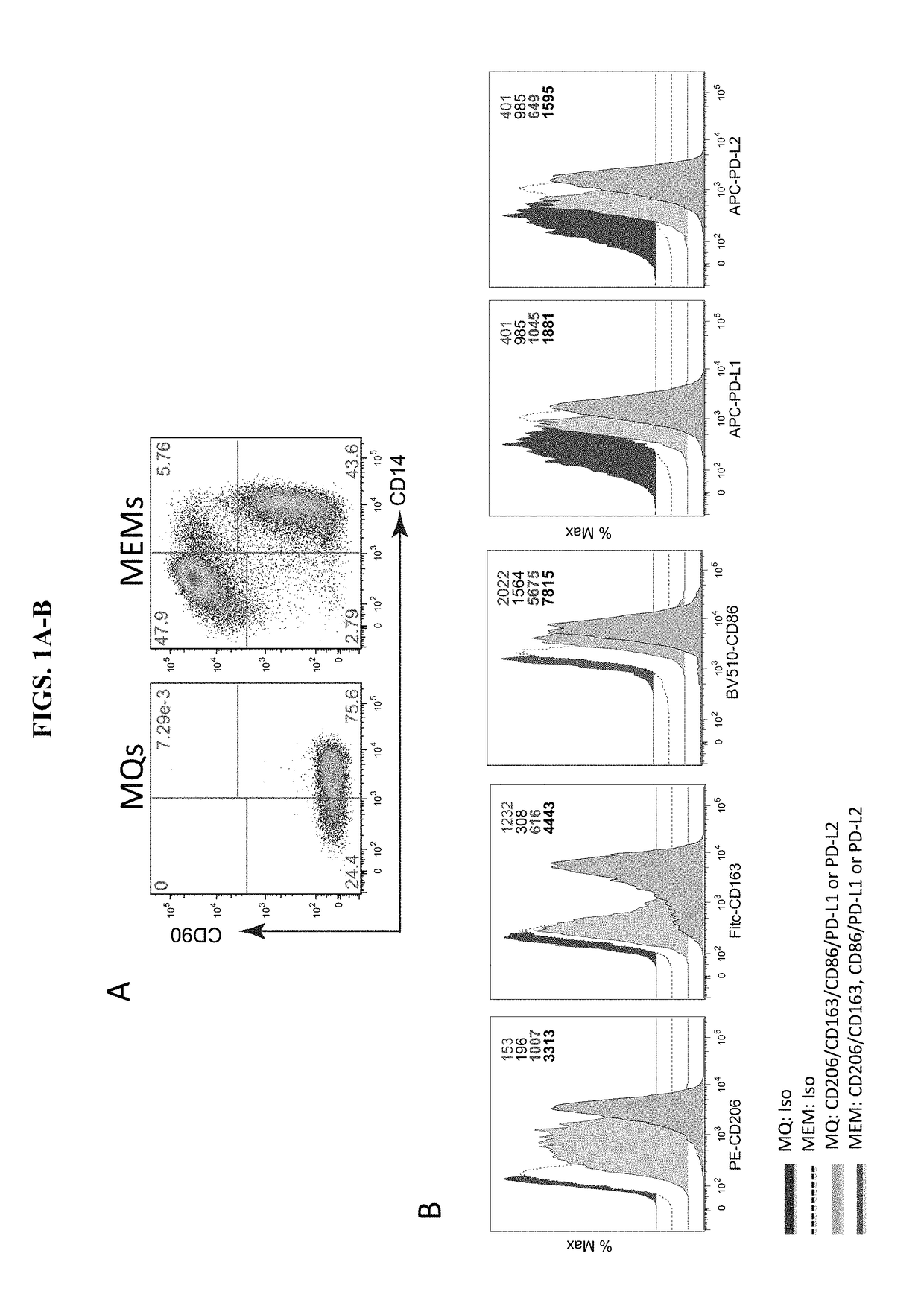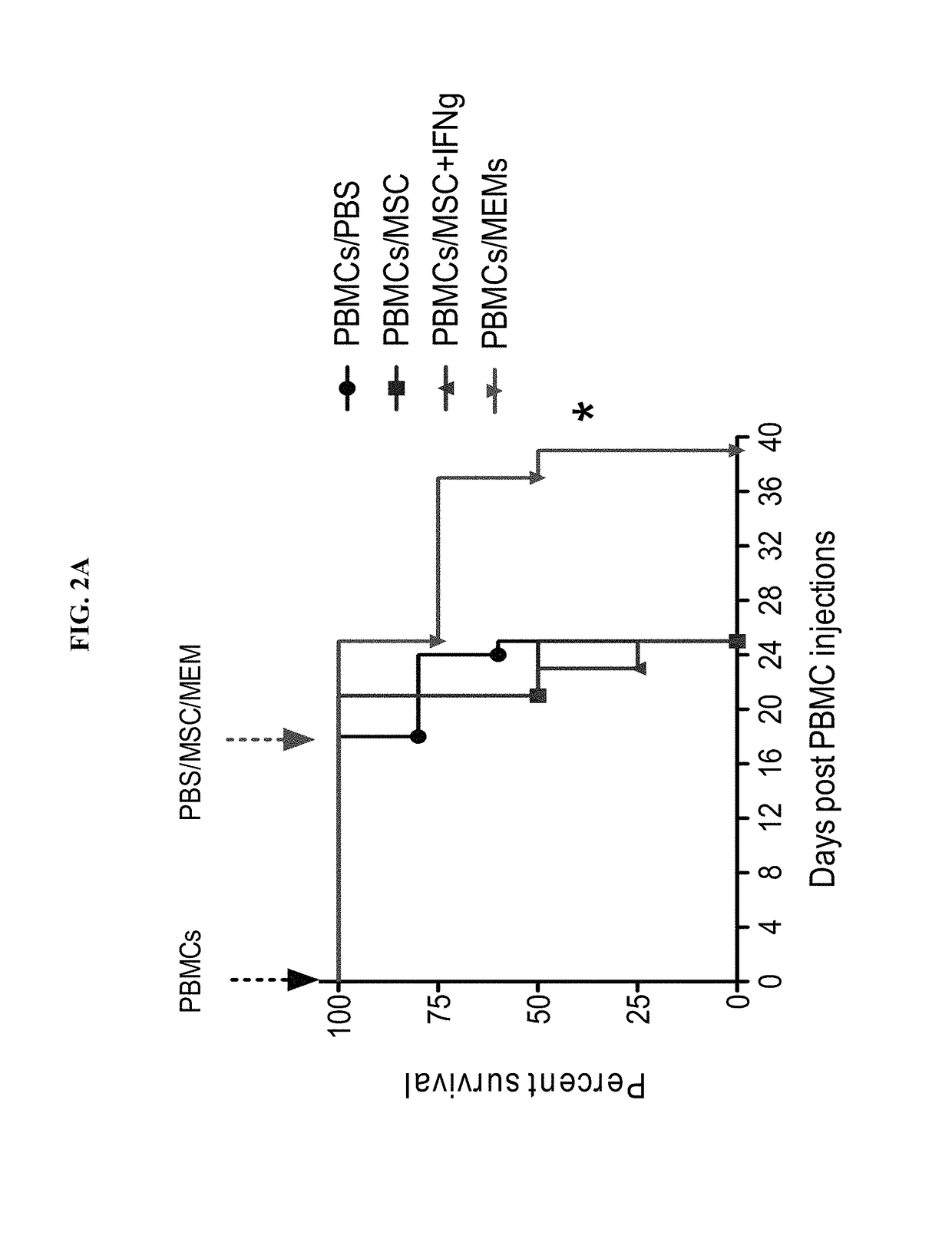Use of mesenchymal stem cell-educated macrophages to treat and prevent graft versus host disease and radiation-induced injury
a technology of mesenchymal stem cells and macrophages, which is applied in the field of using antiinflammatory macrophages, can solve the problems of tissue damage, increased risk of graft-versus-host disease, morbidity and mortality, etc., and achieves the effect of improving the impaired lung function and impaired lung function
- Summary
- Abstract
- Description
- Claims
- Application Information
AI Technical Summary
Benefits of technology
Problems solved by technology
Method used
Image
Examples
example 1
Characterization of Macrophages and MSC-Educated Macrophages (MEMs)
[0074]To assess the in vitro phenotype of macrophages and MEMs (FIG. 1), CD14+ monocytes were isolated from peripheral blood mononuclear cells (PBMCs) from a healthy human donor. The CD14+ cells were cultured for about 7 days in a macrophage medium for differentiation into macrophages (MQs). The macrophage medium was IMDM (Iscove's Modified Dulbecco's Medium) supplemented with 10% human serum blood type AB, 1× Non-essential amino acids, 4 mM L-Glutamine, 1 mM Sodium pyruvate and 4 μg / ml recombinant human insulin. On day 5 to day 7, half of the MQs were cultured with MSCs at a 10:1 ratio for one to seven additional days, while the remaining MQs were cultured without MSCs in macrophage media for one to five days more. The resulting cells of each culture group were stained with antibodies and sorted using flow cytometry (FIG. 1A). Both MQs and MEMs were CD14+ / CD90−, however MEMs had high levels of expression of CD206 an...
example 2
Effects of Administering MEMs in Humanized Mouse Model of GVHD with and without Radiation
[0076]An experimental mouse model for induction of xenogeneic GVHD was obtained using immunodeficient NOD / PRKDC-Scid / IL2 receptor-γ knockout (NSG) mice purchased from Jackson Lab and bred at the University of Wisconsin-Madison. On day 0, NSG mice received a dose of human peripheral blood mononuclear cells (PBMCs) intravenously (i.v.) to induce lethal xenogeneic GVHD. Some mice were randomly selected to receive 2.5 or 3 Gy irradiation (sub-lethal irradiation) on day 0 before PBMC transplant or other experiments. Some mice were randomly selected to receive irradiation after the PBMC transplant to induce inflammation (i.e., day 40). When mice developed clinical symptoms of GVHD (such as weight loss, slower activity, hunching posture, roughness of fur and skin denuding), mice were scored into four treatment groups such that each group started with the same overall GVHD clinical score (see Table 1 be...
example 3
Protective Effects of Administering MEMs in Mouse Model of Radiation-Induced Injury
[0085]To obtain an experimental model of radiation-induced tissue damage in immunodeficient mice, CD14+ monocytes were freshly isolated from the peripheral blood of healthy human donors and cultured as above for 7 days to obtain macrophages (MQs). On day −3, MQs were maintained in a culture medium alone (undifferentiated) or grown in the presence of MSCs to generate MSC-educated-macrophages (MEMs). On day 0, NOD / PRKDC-Scid / IL2 receptor-γ knockout (NSG) mice received a lethal dose of 3 Gy total body irradiation. As shown in FIGS. 5A-D, we found that a single infusion of human MEMs on the day of the radiation insult can significantly enhance survival in an immunodeficient NSG mouse model as compared to the same number of MSCs.
[0086]We performed a separate experiment to compare no treatment and an infusion of macrophages to MEMs and MSCs. Three hours post-irradiation, the mice were divided into four grou...
PUM
 Login to View More
Login to View More Abstract
Description
Claims
Application Information
 Login to View More
Login to View More - R&D
- Intellectual Property
- Life Sciences
- Materials
- Tech Scout
- Unparalleled Data Quality
- Higher Quality Content
- 60% Fewer Hallucinations
Browse by: Latest US Patents, China's latest patents, Technical Efficacy Thesaurus, Application Domain, Technology Topic, Popular Technical Reports.
© 2025 PatSnap. All rights reserved.Legal|Privacy policy|Modern Slavery Act Transparency Statement|Sitemap|About US| Contact US: help@patsnap.com



